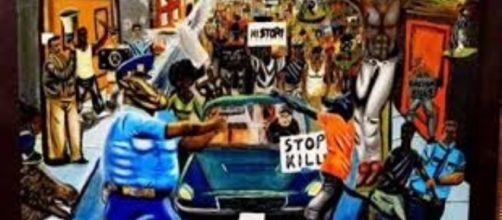Terrorism, gun violence, and drug addiction are some of our problems de jour. Uncertainty about the Affrordable Care Act is another concern, along with apprehension about the temperamental, tweeting President-elect, all his possible conflicts of interest, and his disdain for Intelligence Agencies. Clearly, the incoming Congress has a lot of challenges; yet several Republican House members chose to challenge an art work by a teenage boy.
Using art to change minds
The boy, David Pulphus, a student at the Cardinal Ritter College Prep High School in St.
Louis Missouri, painted a picture of African-American anger at the way law enforcement treats them. His untitled painting was one of 435 winners in a national art contest sponsored by Rep. William Lacy Clay (D-MO) and hung in the Capitol Building basement. But those Republicans who objected to the painting invoked a House Office Building Commission rule that frowns on political art on the premises and took it down. It’s notable that while Speaker Paul Ryan went along with the take-down effort, he had a caveat that the picture stay put until the Martin Luther King holiday ended. That delay suggests that Ryan saw the painting as an act of non-violent protest in sync with Dr. King’s philosophy.
As angry as the teenager clearly was, he didn’t throw rocks at police, or start a riot or loot. He just made a picture.
Fighting with a brush instead of a bullet
This column’s first reaction to the news of this story was one of surprise that Congressmen would took notice of a painting. As it turns out, they didn’t until the Independent Journal Review, reportedly a right-wing publication, wrote about the picture under the headline “Painting of Cops as Pigs Hung Proudly in US Capitol.” That’s a little like describing Michelangelo’s “David” as a teenager exposing himself in public.
There’s no doubt that the teenager’s painting is outrageous. But isn’t that because he is himself outraged? And isn’t that what art-making is all about? In the words of famed social realist Ben Shahn, recorded in a 1973 book of his graphic works by Kenneth W. Prescott, “‘I once told a student that there are just two things to paint - the things you are very strongly for and the things you are very strongly against.” Apparently Shahn and the teenager shared similar beefs when it comes to police treatment of blacks. In his 1944 serigraph titled “Laissez-faire,” Shahn pictures a cop turning his back on a fist fight as a white man attacks another man who is black.

